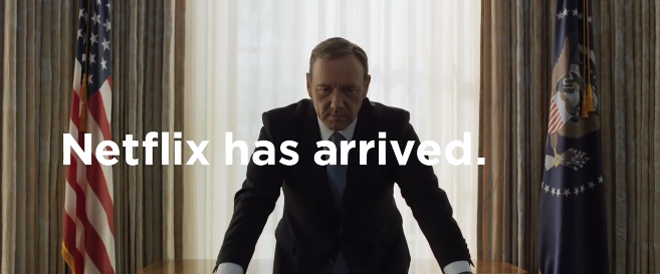The SVOD knee-jerk: Lightbox, Neon, Quickflix and traditional broadcasters respond to the arrival of Netflix

Netflix, which launched in the Kiwi market today, yesterday announced that its pricing structure will include three different subscription options: $9.99 for single-stream standard definition plan; $12.99 for a two-stream high-definition plan; or $15.99 for a four-stream ultra-high definition plan. And this announcement has been met with swift responses by the players currently in the market.
/p>
According to a report published on the NBR website this morning, Netflix will however only offer one eighth of the programming available in the United States (something, which could encourage users to continue accessing the US site through proxy IP addresses). Information taken from a study conducted by tech blogger Kenneth Tsang shows that the local version of Netflix will only offer 1,116 titles compared to the 8,499 available in the US.
Despite the service being slight watered down, Lightbox responded by dropping its subscription price from $15 a month to $12.99 to bring it line with the mid-range plan offered by the newcomer. This price change conveniently also coincides with the announcement of the arrival of new shows Wolf Hall, The Lizzie Borden Chronicles, X Company and Powers.
On the advertising side, Lightbox has also been running a TVC promoting its shows on linear TV. It’s worth noting that at the end of the promo, the TVC includes a reference to the Netflix-produced Orange is the New Black, a show that has also featured on TVNZ Ondemand in the past. With the arrival of Netflix in the market, it is unlikely that this content-sharing partnership will continue given that respective providers are now in competition with each other.
Neon, which has been criticised for charging too much at $20, has not lowered its price, but has also announced a range of new films to be pulled from the Rialtocatalogue. Now available also available on Neon are Much Ado About Nothing, The Queen Of Versailles, The Raid 2, Arthur Newman, Ginger and Rosa, Breathe In The Manor, Private Peaceful, Mood Indigo, Only Lovers Left Alive, The Necessary Death Of Charlie Countryman, Mystery Road, Good Ol Freda, Concussion, The Best Offer, The Brass Teapot and Love Is All You Need.
Neon is also currently running a slightly off-beat promotion, which offers subscribers the opportunity to escape from the chores— such as cooking, cleaning or baby-sitting—with the help of the Neon Escape Squad, who will go to the winners’ homes and take undesirable duties off their hands.

Quickflix, the longest-running service in the market, has not announced any programming or pricing changes but responded earlier this week by sending out a three-month trial to members of the media.
And the announcements haven’t only come from the SVOD providers. On the back of yesterday’s SVOD hype*, the traditional broadcasters also released information on an impending update to Freeview (a partnership between TVNZ,MediaWorks, M?ori Television and Radio New Zealand).
Freeview initially launched in 2007 to help Kiwis transition from free-to-air analogue TV to its digital equivalent. And having now completed this transition, the broadcast partnership is set to launch FreeviewPlus, an update that will allow viewers to watch catch-up and premiere shows on their TV rather than solely a tablet or other connected device.
As things currently stand, only 10 percent of televisions in Kiwi homes are hybrid or smart TVs, meaning that the vast majority of Kiwis still need to connect devices—most often via HDMI cables— to their televisions in order to get online connectivity.
FreeviewPlus is essentially the local iteration of hybrid broadcast broadband television (HbbTV), a concept that was first announced in France in 2009 and is now being used across Europe, Australia and Saudi Arabia.
The local launch of FreeviewPlus will be aided by the release of HbbTVs and set top boxes, which will be available at major electronics retailers (LG, Samsung, Sony and Panasonic FreeviewPlus Smart TVs and Dish TV FreeviewPlus set top boxes will be available from April or May).
When the updated service launches in mid-2015, it will centralise the partners’ content available on both linear channels and on-demand, enabling viewers to access all programming consolidated in a single library.
Chief executives Kevin Kenrick (TVNZ), Mark Weldon (MediaWorks) and Paora Maxwell (M?ori Television) each released statements welcoming the arrival of the FreeviewPlus offering in that it will provide a useful link between linear TV and on-demand viewing—and this move is particularly important, given that traditional free-to-air TV is increasingly having to compete with SVOD providers.
While some of the responses on the part of the nation’s on-demand video providers do seem reactive, it’s worth noting that the Kiwi market is relatively young and that the market is changing quickly. And in any evolving market—especially one that’s technology-driven—price- and service-matching are common. But this isn’t necessarily a bad thing for consumers.
When competitors slog it out by offering the best deals, it can push down the price of services. A clear example of this would be in the case of telcos, which through their commercial battles have driven down the cost of broadband and mobile packages over the last few years. In addition to pushing down prices, competition can also encourage service providers to improve what they offer. And, in the case of SVOD, this means better content for viewers.
So while the introduction of yet another SVOD provider might feel like overkill at the moment, it has already proven good for consumers through the lowering of prices and the introduction of new shows. And as the various players continue vying to win over the relatively small audience in rapidly maturing market, the level of competition is only set intensify.
This article was originally run on our sibling website, Stoppress.co.nz




